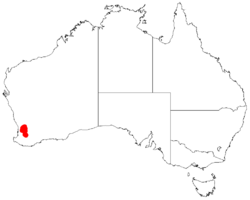Biology:Acacia cuneifolia
| Acacia cuneifolia | |
|---|---|
| Scientific classification | |
| Kingdom: | Plantae |
| Clade: | Tracheophytes |
| Clade: | Angiosperms |
| Clade: | Eudicots |
| Clade: | Rosids |
| Order: | Fabales |
| Family: | Fabaceae |
| Subfamily: | Caesalpinioideae |
| Clade: | Mimosoid clade |
| Genus: | Acacia |
| Species: | A. cuneifolia
|
| Binomial name | |
| Acacia cuneifolia Maslin
| |

| |
| Occurrence data from AVH | |
Acacia cuneifolia is a shrub belonging to the genus Acacia and the subgenus Phyllodineae endemic to south western parts of Australia .
Description
The erect straggly shrub typically grows to a height of 1.0 to 3.0 metres (3.3 to 9.8 ft).[1] It has glabrous to puberulous branchlets with stipules that are 1 to 3 mm (0.039 to 0.118 in) in length. The evergreen phyllodes are variably shaped but most often cuneate to oblong-cuneate. They have a length of 8 to 15 mm (0.31 to 0.59 in) and a width of 2 to 6 mm (0.079 to 0.236 in) wide with a prominent central midrib.[2] It blooms from July to October and produces yellow flowers.[1] The simple inflorescences occur in groups of one to six per axil and have spherical flower-heads with a diameter of 3.5 to 4.5 mm (0.14 to 0.18 in) containing 23 to 26 golden flowers. The glabrous strongly curved to loosely coiled seed pods that form after flowering have a length of up to 5 cm (2.0 in) and are 4 to 6 mm (0.16 to 0.24 in) wide and contain dull dark brown seeds with an oblong to slightly elliptic shape that are 4 to 5 mm (0.16 to 0.20 in) in length.[2]
Distribution
It is native to an area in the Wheatbelt region of Western Australia from York in the north to Williams in the south where it is found on hills, among granite outcrops and along stony watercourses growing in sandy-clay-loamy soils.[1]
See also
References
- ↑ 1.0 1.1 1.2 "Acacia cuneifolia". FloraBase. Western Australian Government Department of Parks and Wildlife. https://florabase.dpaw.wa.gov.au/browse/profile/14067.
- ↑ 2.0 2.1 "Acacia cuneifolia". World Wide Wattle. Western Australian Herbarium. http://worldwidewattle.com/speciesgallery/cuneifolia.php. Retrieved 19 April 2019.
Wikidata ☰ Q9563756 entry
 |


